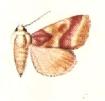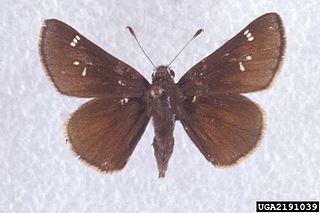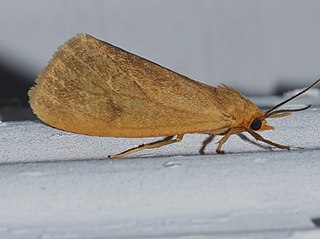
Sphinx dollii, or Doll's sphinx moth, is a moth of the family Sphingidae. It is known from arid brushlands and desert foothills from Nevada and southern California east through Utah, Arizona, Colorado, and from New Mexico to Oklahoma and Texas.

Lintneria eremitoides, the sage sphinx, is a moth from the family Sphingidae. The species was first described by Herman Strecker in 1874. It is known from North America's sandy prairies in the Great Plains from Kansas south through central Oklahoma to Texas, and possibly west to Colorado and New Mexico, and as a rare stray to western Missouri.

Virbia is a genus of tiger moths in the family Erebidae. The genus was erected by Francis Walker in 1854.

Schinia regia is a moth of the family Noctuidae. It is found in North America, including Colorado, Kansas, Nebraska, Oklahoma, New Mexico and Texas.

Virbia aurantiaca, the orange holomelina, is a moth species of the family Erebidae found in North America. In the east it has been recorded from Manitoba and Nova Scotia, south along the eastern seaboard to Cordoba in Mexico. It has also been recorded from Texas, Mississippi, Missouri, Tennessee, Louisiana, Oklahoma, Kansas, North Dakota and South Dakota.

Raphia frater, the brother moth or simply the brother, is a moth of the family Noctuidae. It is found from Nova Scotia west, across the forested regions of Canada to British Columbia, south to Mississippi in the east. The southern limits in the west are uncertain due to confusion with several closely related species or forms.

The reginia primrose moth is a moth of the family Noctuidae. It is found from southern and western Texas, north to the panhandle, north-western Oklahoma, Kansas, Nebraska and west to southern New Mexico and eastern Colorado.

Atrytonopsis hianna, the dusted skipper, is a butterfly of the family Hesperiidae. It is found in the United States from eastern Wyoming, central Colorado, northern New Mexico and central Texas east to New Hampshire and Massachusetts, south to peninsular Florida and the Gulf Coast.

Celotes nessus, the common streaky-skipper, is a butterfly of the family Hesperiidae. It is found in North America from southern Arizona, southern New Mexico, and western Texas south to northern Mexico. Rare strays can be found up to southern Oklahoma and northern Louisiana.

Euphilotes battoides, the square-spotted blue or buckwheat blue, is a species of butterfly of the family Lycaenidae.
Virbia fergusoni is a moth in the family Erebidae. It was described by Jennifer M. Zaspel in 2008. It is found in the south-eastern United States, ranging to South Carolina in the north and from Georgia and northern Florida to Alabama in the west. The habitat consists of mixed oak-pine forests.
Virbia ferruginosa, the rusty holomelina, is a moth in the family Erebidae. It was described by Francis Walker in 1854. It is found from Nova Scotia to British Columbia in Canada. In the United States it is found from the northeast and upper Midwest, south to Virginia, Mississippi, Missouri and Louisiana.

Virbia laeta, the joyful holomelina, is a moth in the family Erebidae. It was described by Félix Édouard Guérin-Méneville in 1844. It is found in North America from New Brunswick south to Florida and west to Minnesota and south to Texas. The habitat consists of pine woodlands.
Virbia lamae, the bog holomelina, is a moth in the family Erebidae. It was described by Thomas Nesbitt Freeman in 1941. It is found in North America in Nova Scotia, New Brunswick, Maine, Wisconsin and Michigan. The habitat consists of open peat bogs.
Virbia nigricans is a moth in the family Erebidae. It was described by Tryon Reakirt in 1864. It is found in the United States in secondary secession habitats of western New Jersey and Pennsylvania.

Virbia opella, the tawny holomelina, is a moth in the family Erebidae. It was described by Augustus Radcliffe Grote in 1863. It is found in the United States from Maine west to Illinois and south to Texas. The habitat consists of oak forests and scrub oak forests.

Virbia ostenta, the showy holomelina, is a moth in the family Erebidae. It was described by Henry Edwards in 1881. It is found in the mountain ranges of New Mexico, Arizona and Mexico.
Virbia rindgei is a moth in the family Erebidae. It is found in Colorado, South Dakota and Wyoming. The habitat consists of ponderosa pine forests.

Virbia rubicundaria, the ruddy holomelina, black-banded holomelina or least holomelina, is a moth in the family Erebidae. It is found from Georgia and Florida, along the Gulf Coast to eastern Texas.
Gnorimoschema saphirinella is a moth in the family Gelechiidae. It was described by Vactor Tousey Chambers in 1875. It is widespread throughout North America, where it has been recorded from Alabama, Arizona, California, Colorado, Florida, Georgia, Illinois, Kansas, Mississippi, New Mexico, North Dakota, Oklahoma, Tennessee and Texas.











